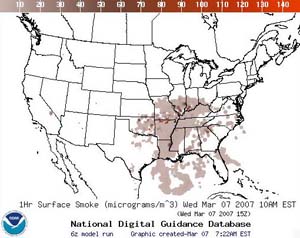| NOAA Magazine || NOAA Home Page |
NOAA NATIONAL WEATHER SERVICE TRANSITIONS SMOKE FORECAST TOOL INTO OPERATIONS
 March
7, 2007 � Expanding its suite of air quality forecast guidance, the
NOAA National Weather Service
has deployed its Smoke Forecast
Tool into operations, following successful experimental testing
over the last ten months. The Smoke Forecast Tool leverages capabilities
both within and outside NOAA to forecast smoke concentrations in the
air we breathe. (Click NOAA image for larger view of surface
smoke forecast guidance as of 10 a.m. EST on March 7, 2007. Please credit
“NOAA.”)
March
7, 2007 � Expanding its suite of air quality forecast guidance, the
NOAA National Weather Service
has deployed its Smoke Forecast
Tool into operations, following successful experimental testing
over the last ten months. The Smoke Forecast Tool leverages capabilities
both within and outside NOAA to forecast smoke concentrations in the
air we breathe. (Click NOAA image for larger view of surface
smoke forecast guidance as of 10 a.m. EST on March 7, 2007. Please credit
“NOAA.”)
“Emissions from large fires are a significant source of fine particle pollution. This type of pollution is responsible for an estimated 50,000 premature deaths each year,” said retired Air Force Brig. Gen. David L. Johnson, director of the NOAA National Weather Service. “Smoke forecast guidance will help air quality forecasters and the public to take steps to limit their exposure to airborne particulate matter.”
The Smoke Forecast Tool integrates the NOAA Satellite and Information Service’s satellite information on the location of wildfires with NOAA National Weather Service weather inputs from the North American Mesoscale model and smoke dispersion simulations from the NOAA Research HYSPLIT model to produce a 48-hour prediction of smoke transport and concentration, updated daily. The model also incorporates U.S. Forest Service estimates for wildfire smoke emissions based on vegetation cover.
“The implementation of the Smoke Forecast Tool as an operational product expands the National Weather Service vision for and end-to-end national air quality forecast capability,” said Paula Davidson, NOAA National Weather Service manager for air quality forecasting. “Our goal is to provide the United States with ozone, particulate matter and other pollutant forecasts with enough accuracy and advance notice to allow people to take action to prevent or reduce adverse effects. The introduction of the Smoke Forecast Tool is the first step toward achieving this goal for particulates.”
The NOAA National Weather Service currently provides next-day forecast guidance for ozone throughout the eastern United States, with experimental predictions covering the lower forty-eight states.
The Smoke Forecast Tool was built and tested by a NOAA team that included efforts from NOAA Research, NOAA Satellite and Information Service, and NOAA National Weather Service. NOAA partners at the U.S. Forest Service provide wildfire emissions information, and the Environmental Protection Agency coordinates with state and local air quality forecasters.
NOAA, an agency of the U.S. Commerce Department, is celebrating 200 years of science and service to the nation. From the establishment of the Survey of the Coast in 1807 by Thomas Jefferson to the formation of the Weather Bureau and the Commission of Fish and Fisheries in the 1870s, much of America's scientific heritage is rooted in NOAA. NOAA is dedicated to enhancing economic security and national safety through the prediction and research of weather and climate-related events and information service delivery for transportation, and by providing environmental stewardship of the nation's coastal and marine resources. Through the emerging Global Earth Observation System of Systems (GEOSS), NOAA is working with its federal partners, more than 60 countries and the European Commission to develop a global monitoring network that is as integrated as the planet it observes, predicts and protects.
Relevant Web Sites
NOAA Air Quality Guidance
Media
Contact:
Dennis Feltgen, NOAA
National Weather Service, (301) 713-0622